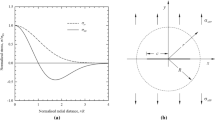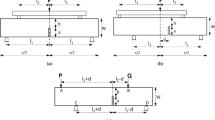Abstract
This paper is the second of three devoted to a detailed study of the three- dimensional deformation at the tip of a notch in a ductile steel plate loaded in three-point bending. A finite element model has been constructed preparatory for a comparison with the experimental data in the subsequent paper; the geometry and material properties have been carefully matched to the experiment described in a preceding paper. The experiments to provide the complete description of the relevant material behavior are presented, followed by the details of the numerical model and some sample results. Young's modulus and the yield behavior are evaluated. Because any error in Poisson's ratio induces an error of the same order of magnitude in the three- dimensional elastic displacement field, this quantity is also measured with moiré interferometry to within ± 1 percent. Also, besides matching the material properties and geometry of the numerical model to the three-point-bend experiment, the development of (tunneling) fracture within the interior of the specimen is determined; these measurements are incorporated into the numerical model by releasing appropriate nodes.
Similar content being viewed by others
References
ASTM E 399–81. (1982). Standard test method for plane-strain fracture toughness of metallic materials. Annual Book of ASTM Standards, Part 10, 592–622.
ASTM E 646–78. (1982). Standard test method for tensile strain-hardening exponents (n-values) of metallic sheet materials. Annual Book of ASTM Standards, Part 10, 762–771.
Bathe, K-J. (1982). Finite Element Procedures in Engineering Analysis, Pretice-Hall, Inc., Englewood Cliffs, N.J.
Bridgman, P.W. (1944). The stress distribution at the neck of a tension specimen. Transactions of the American Society of Metals 32, 553–574.
Bridgman, P.W. (1952). Studies in Large Plastic Flow and Fracture, Metallurgy and Metallurgical Engineering Series (Consulting Editor, R.F. Mehl), McGraw-Hill Book Company, Inc., New York.
Broek, D. (1974). Elemetary Engineering Fracture Mechanics, Noordhoff International Publishing, Leyden.
Gross, B. and Srawley, J.E. (1965). Stress-intensity factors for three-point-bend specimens by boundary collocation. NASA Technical Note TN D-3092, National Aeronautics and Space Administration, Washington, D.C.
Gurson, A.L. (1977). Continuum theory of ductile rupture by void nucleation and growth - Part I: Yield criteria and flow rules for porous ductile media. Journal of Engineering Materials and Technology 99, 2–15.
Hertzberg, R.W. (1989). Deformation and Fracture Mechanics of Engineering Materials, Third Edition, John Wiley and Sons, New York.
Hughes, T.J.R. (1980). Generalization of selective integration procedures to anisotropic and nonlinear media. International Journal for Numerical Methods in Engineering 15, 1413–1418.
Hutchinson, J.W. (1968a). Singular behaviour at the end of a tensile crack in a hardening material. Journal of Mechanics and Physics of Solids 16, 13–31.
Hutchinson, J.W. (1968b). Plastic stresses and strain fields at a crack tip. Journal of Mechanics and Physics of Solids 16, 337–347.
Ledbetter, H.M. and Read, R.P. (1973). Elastic properties of metals and alloys, I. Iron, nickel and iron-nickel alloys. Journal of Physical and Chemical Reference Data 2, 531–617.
Li, F.Z., Shih, C.F. and Needleman, A. (1985). A comparison of methods for calculating energy release rates. Engineering Fracture Mechanics 21, 405–421.
Matic, P., Kirby III, G.C., Jolles, M.I. and Father, P.R. (1991). Ductile alloy constitutive response by correlation of iterative finite element simulation with laboratory video images. Engineering Fracture Mechanics 40, 395–419.
Nakamura, T., Shih, C.F. and Freund, L.B. (1985). Elastic-plastic analysis of a dynamical loaded circumferentially notched round bar. Engineering Fracture Mechanics 22, 437–452.
Nakamura, T., Shih, C.F. and Freund, L.B. (1986). Analysis of a dynamically loaded three-point-bend ductile fracture specimen. Engineering Fracture Mechanics 25, 323–339.
Narasimhan, R. and Rosakis, A.J. (1988). A finite element analysis of small-scale yielding near a stationary crack under plane stress. Journal of Mechanics and Physics of Solids 36, 77–117.
Narasimhan, R. and Rosakis, A.J. (1990). Three-dimensional effects near a crack tip in a ductile three-point bend specimen - Part I: A numerical investigation. Journal of Applied Mechanics 57, 607–617 (See also California Institute of Technology Report SM 88–6, Pasadena, 1988).
Narasimhan, R., Rosakis, A.J. and Moran, B. (1992). A three-dimensional numerical investigation of fracture initiation by ductile failure mechanisms in a 4340 steel. International Journal of Fracture 56, 1–24 (See also California Institute of Technology Report SM 89–5, Pasadena, 1989).
Pfaff, R.D. (1991). Three-Dimensional Effects in Nonlinear Fracture Explored with Interferometry, Ph.D. Thesis, California Institute of Technology, Pasadena, California.
Polakowski, N.H. and Ripling, E.J. (1966). Strength and Structure of Engineering Materials, Prentice-Hall, Inc., Englewood Cliffs, New Jersey.
Post, D. (1993). Moiré interferometry. Handbook on Experimental Mechanics, Second Revised Edition (Edited by A.S. Kobayashi), Society for Experimental Mechanics, Inc., Prentice-Hall, Inc., Englewood Cliffs, New Jersey, 297–364.
Post, D., Han, B. and Ifju, P. (1994). High Sensitivity Moiré, Experimental Analysis for Mechanics and Materials, Springer-Verlag, New York.
Press, W.H., Flannery, B.P., Teukolsky, S.A. and Vetterling, W.T. (1986). Numerical Recipes, Cambridge University Press, Cambridge.
Rice, J.R. (1968a). A path independent integral and the approximate analysis of strain concentration by notches and cracks. Journal of Applied Mechanics 35, 379–386.
Rice, J.R. (1968b). Mathematical analysis in the mechanics of fracture. Fracture, An Advanced Treatise (Edited by H. Liebowitz) Volume II, Mathematical Fundamentals, Academic Press, New York, 191–311.
Rice, J.R. and Rosengren, G.F. (1968). Plane strain deformation near a crack tip in a power-law hardening material. Journal of Mechanics and Physics of Solids 16, 1–12.
Rooke, D.P. and Cartwright, D.J. (1976). Compendium of Stress Intensity Factors, Her Majesty's Stationery Office, London.
Schultheisz, C. (1991). Comparison of Experimental and Computational Crack-Tip Deformations Using Moiré Interferometry and Finite Elements, Ph.D. Thesis, California Institute of Technology Report SM 91–1, Pasadena.
Schultheisz, C.R., Pfaff, R.D. and Knauss, W.G. (1998). An experimental/analytical comparison of three-dimensional deformations at the tip of a crack in a plastically deforming plate. I. Optical interferometry and experimental preliminaries, this issue, pp. 1–25. III. Comparison of numerical and experimental results, this issue, pp. 47–81.
Shih, C.F. (1983). Tables of Hutchinson-Rice-Rosengren Singular Field Quantities, MRL E-147, Materials Research Laboratory Report, Brown University, Providence.
Shih, C.F., Moran, B. and Nakamura, T. (1985). Energy release rate along a three-dimensional crack front in a thermally stressed body. International Journal of Fracture 30, 79–102.
Structural Alloys Handbook, Volume 1, 1987 Edition, Battelle's Columbus Division, Metals and Ceramics Information Center.
Tada, H., Paris, P.C. and Irwin, G.R. (1973). The Stress Analysis of Cracks Handbook, Del Research Corporation, Hellertown, Pennsylvania.
Williams, M.L. (1957). On the stress distribution at the base of a stationary crack. Journal of Applied Mechanics 24, 109–114.
Zehnder, A.T. (1987). Dynamic Fracture Initiation and Propagation in Metals: Experimental Results and Techniques, Doctoral Thesis, California Institute of Technology.
Author information
Authors and Affiliations
Rights and permissions
About this article
Cite this article
Schultheisz, C., Pfaff, R. & Knauss, W. An Experimental/Analytical Compression of Three-Dimentional Deformations at the Tip of a Crack in a Plastically deforming Plate II: Material Characterization and finite element analysis. International Journal of Fracture 90, 27–46 (1998). https://doi.org/10.1023/A:1007403820924
Issue Date:
DOI: https://doi.org/10.1023/A:1007403820924




